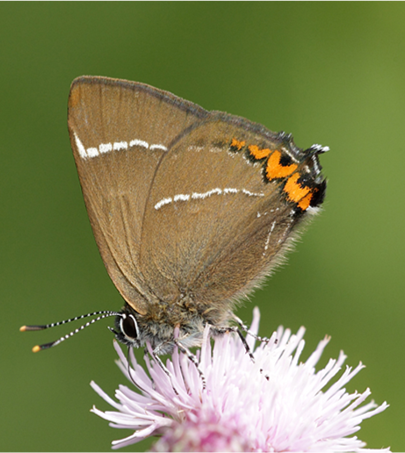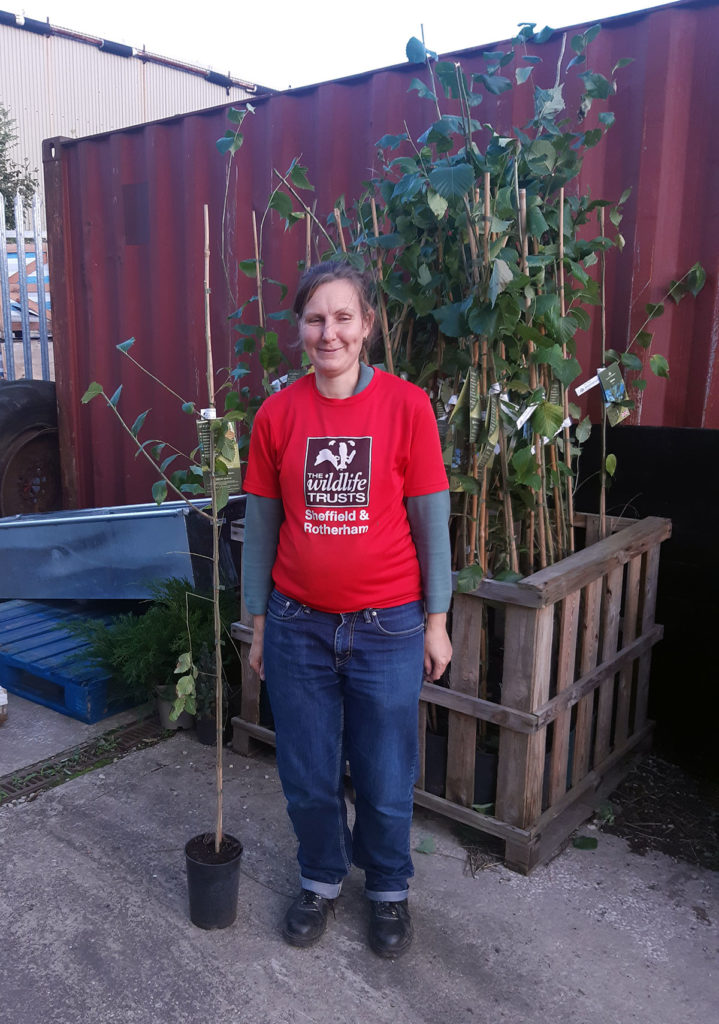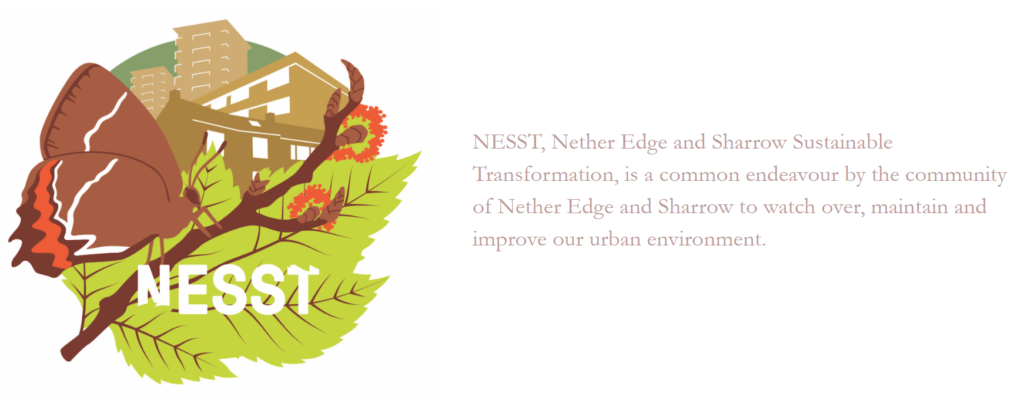Help create a resilient habitat for White-letter Hairstreak butterflies by purchasing a Dutch Elm Disease resistant sapling to plant, or donate for us to place one in a suitable location as part of our Elms and Hairstreaks Initiative!
Thank you!
The initial allocation of elm saplings have now sold out. We hope to offer similar schemes in future so please check back soon. In the meantime, you can find more ways to take action for nature in our Nature Recover Community Toolkit.
About the Elms and Hairstreaks Initiative
The deadly Dutch Elm Disease (DED) has decimated nearly all of the UK’s large mature elm trees. Mature elms have their own unique biodiverse species mix of lichens and insects, many of which declined as elm trees have disappeared. The most famous species dependent solely on elms is the White-letter Hairstreak butterfly, whose abundance has declined by up to 78% in England since 1976*.
Now Sheffield & Rotherham Wildlife Trust and Nether Edge & Sharrow Sustainable Transformation (NESST) are working together in partnership (supported by Sheffield City Council) on the Elms and Hairstreaks Initiative which aims to make our region a place where both species can thrive again.
Half a century of research and breeding in specialist nurseries has produced DED resistant elm trees. We have purchased 50 DED saplings, and we want you to help us plant them here!
Photograph: © Ben Keywood
*The UK Butterfly Monitoring Scheme & State of UK Butterflies

How it works
Participate in the initiative and help plant a young elm sapling – in your garden, on your land, or even in one of our nature reserves – and you could transform the fortunes of both the elm and the hairstreak!
To purchase an Elm to plant yourself:
(If you don’t have space to plant an elm of your own, choose the ‘donate an elm’ option below)
Order your DED Resistant sapling(s)
Online ordering is available via our Eventbrite, booking one of the below timeslots to collect. The price of each sapling is just £20 (plus Eventbrite fees).
Collect your sapling
Bring your e-ticket during your chosen timeslot to collect your tree sapling. Collection is from Sheffield & Rotherham Wildlife Trust, Victoria Hall, 37 Stafford Road, Sheffield, S2 2SF.
The saplings are approximately 2.5 metres tall, and have the potential to grow to 30 metres tall with a 8m wide canopy in maturity! Please arrange suitable transport (e.g. flatten back seats of a car). Bringing a large bag such as a binbag is advisable to wrap the muddy base of the saplings.
Plant your Elm tree sapling
Plant in a suitable location and allow it to grow. Elm grows best in well-drained soil in hedgerows and woodland. It is really important that you let us know during the checkout process where you plan to locate it, so we can map and record DED resistant Elm locations across the city.
Record your wildlife sightings
Over the coming years we aim to evaluate the success of the initiative by recording the population of White-letter Hairstreak butterflies and other species, and would appreciate you helping us to do so by recording your sightings to the Nature Counts database via our website.

To sponsor an Elm:
Sheffield & Rotherham Wildlife Trust, NESST and Sheffield City Council have worked together to identify locations where DED resistent Elm trees would be beneficial.
For those unable to plant a sapling in their own garden or land, we are giving you the opportunity to donate the cost to enable us to do so.
Simply click the link to purchase a sapling, and we’ll take care of the rest!
Favoured sites to plant donated saplings are Greno Woods, Carbrook Ravine and Carr House Meadows nature reserves (Sheffield & Rotherham Wildlife Trust) and Norfolk Park (Sheffield City Council). High Hazels Park, Lynwood Gardens and Clay Wood are reserve sites to complement Sheffield City Council’s own planting of resistant elm trees.
Together we can increase the population of the White-letter Hairstreak butterfly!

Nature Natters: Elms and Hairstreaks
Watch our Nature Natters event for more information on the Elms and Hairstreaks Initiative and more!
Sheffield & Rotherham Wildlife Trust butterfly expert Ben Keywood and Paul Selby, chair of Nether Edge and Sharrow Sustainable Transformation (NESST), offer a fascinating look at the relationship between the rare White-letter Hairstreak butterfly and Elm trees; and how you may be able to help both!
Elms and Hairstreaks Initiative FAQs
Download the document below for answers to some of the questions you might have about the projects. For any further questions, please get in touch by emailing takeaction@wildsheffield.com.
About the White-letter Hairstreak butterfly
The White-letter Hairstreak (Satyrium w-album) butterfly is so called because of the markings on its wings that suggest a scrawled letter ‘w’ (indeed it has previously been called the White w-Hairstreak). This helps to distinguish this butterfly from other hairstreaks such as the Black. The White-letter Hairstreak is a species that thrives in the high canopy of mature elm trees, drawing on nectar from flowers and laying eggs on small branches to overwinter.
There has been a marked decline in the abundance of White-letter Hairstreak, estimated as a loss of 99% of the population over 25 years (1984-2003 Defra/JNCC UK Priority Species Report). Being a high canopy butterfly, it can make it difficult to spot this elusive butterfly and assess population changes but given the loss of mature English elms from England in the 1970s onwards, it is not surprising to see such a decline in this species. The White-letter Hairstreak butterfly is endangered and on the Butterfly Red Data List for the UK.
About Elm trees
Elm trees support a wide variety of species, lichens, mosses and insects, including the White-letter Hairstreak butterfly. But elm trees have been and continue to be in trouble.
Mature English Elms (Ulmas major) were once common on the rich farmed soils of middle England but are now rarely found as trees and are more common as hedgerow shrubs. This decline is a likely result of the ravaging effects of a recent wave of Dutch elm disease which has affected all the UK’s elms, killing many mature trees and preventing new trees from growing.
Many mature trees have been lost, but elms still cling on, in part due to their ability to easily form new varieties and reproduce by both seed and sucker.
How to identify
- Height: 16-30m
- Elms can be recognised by their asymmetrical oval leaves, toothed around the edges, with very short stalks, as well as their winged fruit. English Elm has smaller, rounder leaves than Wych Elm.